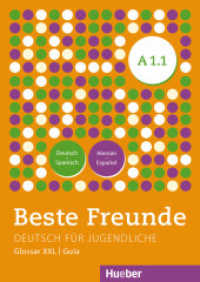- ホーム
- > 洋書
- > 英文書
- > Psychology
基本説明
The interest of experimental psychology and cognitive neuroscience on imagery and spatial cognition is remarkably increased in the last decades. The aim of this book is to provide the reader (post-graduate students as well as experts) with a complete overview of this field of research. It illustrates how brain, behaviour and cognition interact in normal and pathological subjects in perceiving, representing and exploring space.
Full Description
The relationships between perception and imagery, imagery and spatial processes, memory and action: these are the main themes of this text. The interest in experimental psychology and cognitive neuroscience on imagery and spatial cognition has remarkably increased in the last decades. Different areas of research contribute to the clarification of the multiple cognitive processes subserving spatial perception and exploration, and to the definition of the neurophysiological mechanisms underpinning these cognitive functions. The aim of this book is to provide the reader (post-graduate students as well as experts) with a complete overview of this field of research. It illustrates how brain, behaviour and cognition interact in normal and pathological subjects in perceiving, representing and exploring space.(Series B)
Contents
1. List of contributors; 2. Introduction; 3. SECTION 1: Methodology of imagery and visuo-spatial functions; 4. Early methods for assessing imagery and nonverbal abilities (by Richardson, John T.E.); 5. The assessment of imagery and visuo-spatial working memory functions in children and adults (by Mammarella, Irene C.); 6. Do we only remember where we left our things when we expect to need them again: Expectancy manipulations and object-location memory (by Postma, Albert); 7. Variations on the image scanning paradigm: What do they contribute to our knowledge of mental imagery? (by Denis, Michel); 8. The use of transcranial magnetic stimulation in spatial cognition (by Oliveri, Massimiliano); 9. SECTION 2: Models and components of imagery and visuo-spatial processes; 10. Neural bases and cognitive mechanisms of Human Spatial Memory (by Panagiotaki, Panagiota); 11. Working memory, imagery and visuo-spatial mechanisms (by Cattaneo, Zaira); 12. The episodic buffer: Implications and connections with visuo-spatial research (by Pearson, David G.); 13. Visuo-spatial components of numerical representation (by Hevia, Maria-Dolores de); 14. Motor components and complexity effects in visuo-spatial processes (by Logie, Robert H.); 15. SECTION 3: Aging and visuo-spatial abilities; 16. Aging and Visuo-spatial working memory (by Cavallini, Elena); 17. Imagery and aging (by Palladino, Paola); 18. Object-location memory in ageing and dementia (by Kessels, Roy P.C.); 19. Visuospatial and constructional impairments in mental deterioration (by Grossi, Dario); 20. Using visual imagery as a mnemonic for verbal associative learning: Developmental and individual differences (by Hertzog, Christopher); 21. SECTION 4: Neuropsychological aspects of space representation; 22. Spatial navigation: Cognitive and neuropsychological aspects (by Guariglia, Cecilia); 23. Visuomotor control of spatially directed action (by Milner, A. David); 24. Visual peripersonal space (by Serino, Andrea); 25. Visual perceptual processing in unilateral spatial neglect: The case of visual illusions (by Vallar, Giuseppe); 26. The impairment of the body image in the unilateral neglect syndrome (by Bottini, Gabriella); 27. Simulating object-centred neglect with head-centred coding of space based on non-linear gaze-dependent units (by Silvetti, Massimo); 28. Omission vs. shift of details in spatial representations (by Toraldo, Alessio); 29. Name Index; 30. Subject Index







